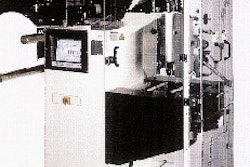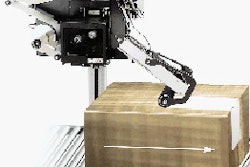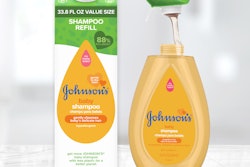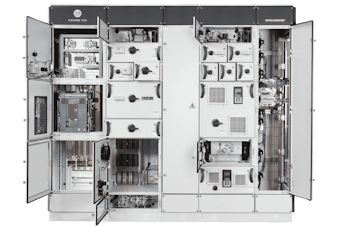
The new machines are Pack 300/CA models from Klockner Packaging Machinery (Sarasota, FL). Each machine is capable of wrapping at speeds to 1귔 pieces/min, depending on product consistency and film characteristics. Nabisco uses the new wrappers for five different flavors of its Lifesavers hard candies.
For perhaps generations, Lifesavers have been packed exclusively as candies in foil/paper rolls (see PW, Feb. '99, p. 2 or packworld.com/go/lifesavers). However, responding to self-service merchandising, the need for tamper-evidence and a desire to sell in larger quantities, Lifesavers and many other hard candies have added individually wrapped candies that can be packed in bags for self-service display on pegs or on shelves.
At the same time, Nabisco has broadened the Lifesavers product line with many new flavors and varieties of Lifesavers. These new products have required some changes in wrapping materials, including those that can be heat-sealed and others that require cold seals.
Similarly, says Jim Prunesti, manager of packaging engineering for Nabisco's U.S. Foods Group, some products are best wrapped in oriented polypropylene with a heat-seal coating, others in a coextruded OPP film and still others in a metallized OPP with a cold-seal coating. He declined to identify sources.
"We now have many product lines under the Lifesavers brand, and there is a range of barrier properties that some formulations require that other Lifesavers products don't need," he says. "Plus we've found that some product formulations will actually interact with certain packaging materials. These are the reasons we need to use different structures for different Lifesavers products."
Changes demand servos
Prior to the addition of the new wrappers, "All of Nabisco's existing flow wrappers were mechanically driven machines, not servo-driven," says Dave Hipenbecker, U.S. Foods Group director of engineering. "For any equipment we purchase today, we always look for servo technology. We find that servos give us the ability to maximize throughput. They also provide the flexibility to adjust parameters to accommodate future, as-yet-undefined products."
The company began to seek new packaging capacity more than two years ago, using a team consisting of representatives from Nabisco's corporate engineering group and manufacturing operations at the two plants where the new equipment eventually was installed. The company previously had used a combination of both high- and low-speed wrappers.
The team first evaluated different vendors of flow wrappers, and it eventually narrowed the field to two companies. By the summer of '97, the team began intensive testing of the appropriate machines from the two suppliers. Each was tested extensively using Nabisco's Lifesavers products. The Klockner Pack 300/CA machine was installed at a Lifesavers plant for a six-week on-site test, side-by-side with the mechanically driven wrappers. The competitive machine wasn't available for on-site tests, but was still closely evaluated.
More uptime
The primary advantage of the servo-driven wrappers was a major increase in overall uptime. This is due to "on-the-fly" adjustments, easier and faster changeover and simpler troubleshooting and overall maintenance.
"Servo technology allows us to make adjustments to the machine and to customize operations even while the machine is running," Prunesti points out. "If we need to change the length of the pack, for example, we can do it 'on the fly' with a servo machine by making a change on the operator screen.
"With mechanical equipment, we'd have to physically stop the machine, use tools to make the mechanical adjustments and then start up the machine again," Prunesti comments. Pack length can be changed up to ±8 mm without change parts on the Klockner machine. Even on a more involved change, he says "the only parts we might have to change would be the feed disk and forming box." It would be far more involved on a mechanically driven wrapper, he adds.
On the machine, film is fed from a servo-driven, ergonomically designed film tower equipped with quick lock/release cones. The film is drawn over the forming box where two sets of heated rollers make the fin seal. The machine's cantilevered cross sealing jaws are enclosed by a transparent cover with safety interlocks.
Troubleshooting is far easier on machines driven by servo motors, adds Hipenbecker. "There are fewer moving parts, and that means less wear. Servos provide a level of reliability and easy maintenance not possible with mechanical equipment," he says. However, for mechanics, "it's quite a shock not having to carry wrenches all the time!"
Increased output
"From the outset, we knew that we could achieve higher throughput than we had with our older flow wrappers. One of the goals of our testing was to determine exactly how much faster we could run," says Prunesti. Nabisco wouldn't divulge actual operating speeds. When asked whether Nabisco was achieving speeds close to the rated 1귔/min speed of the machine, Prunesti answered affirmatively.
In fact, the only number that Nabisco would verify is the 15% increase in overall throughput. By coupling this with the fact that its plants did not add any extra bagging capacity, it's obvious that the mechanical flow wrappers had been the limitation to output in the past. It's also important to point out that none of the previous equipment was replaced; the new "groups" of wrappers all meant additional capacity for Nabisco, according to Hipenbecker. The new machines were delivered in late spring '98, although the company declines to identify neither the number nor the locations for the machines.
In the end, the Klockner machines were chosen because of their consistently greater throughput. "Even more important was the company's willingness to work with us to customize the electronics and operator interface," Prunesti says. "Klockner was responsive to our needs from the beginning and developed a real partnership with us."
Good support, too
As well, Nabisco's own operators and mechanics were enthusiastic about the machines they had worked with in the plant. "These are the people who work with the machinery day in and day out," Prunesti adds, "so their opinions are critical. Plus, we knew from past experience with Klockner that the company provides reliable service, support and good training."
A Klockner technician provided training and support for the start-up. Nabisco found that it really didn't need much time for debugging and shake-out. Within a week after installation, Prunesti says the machines were all operating at their expected higher throughputs.






















